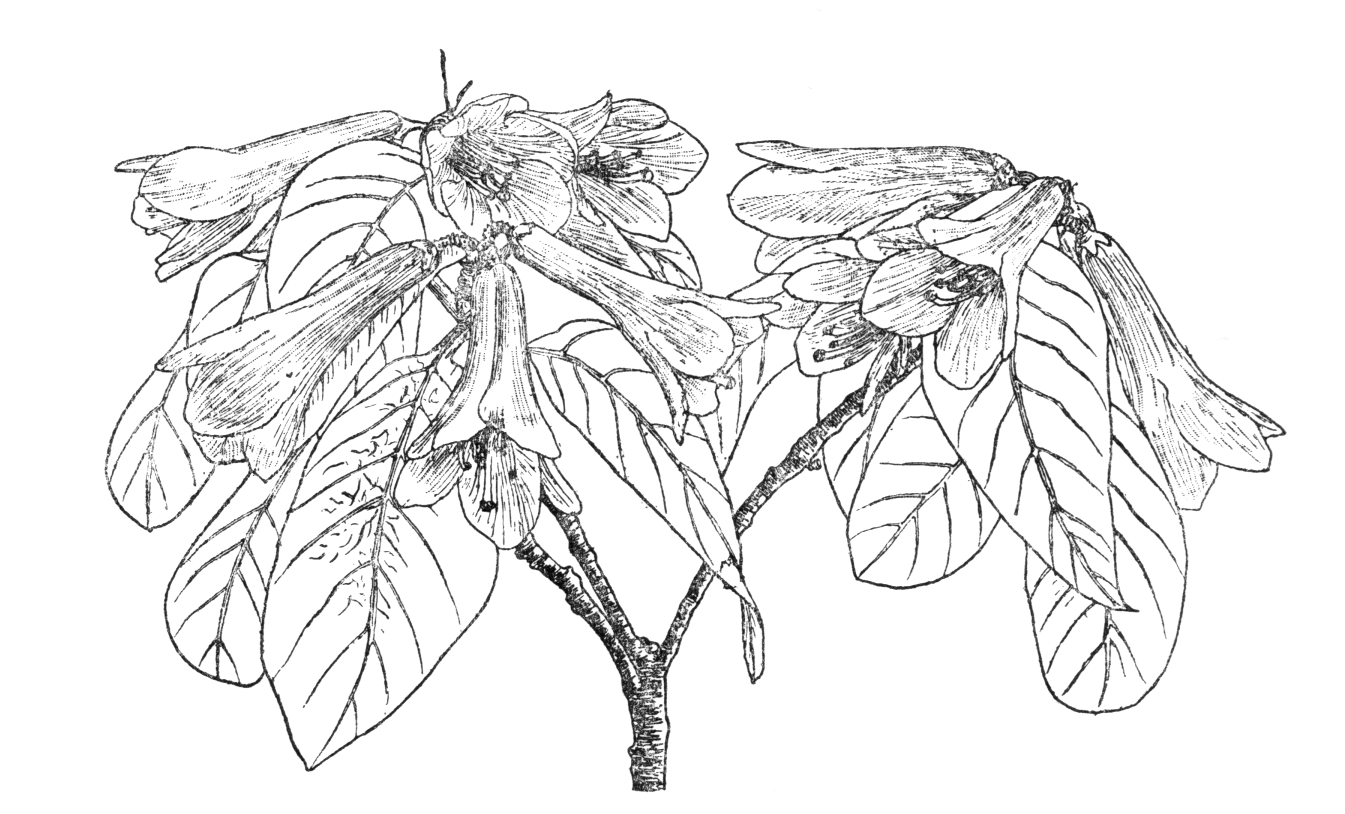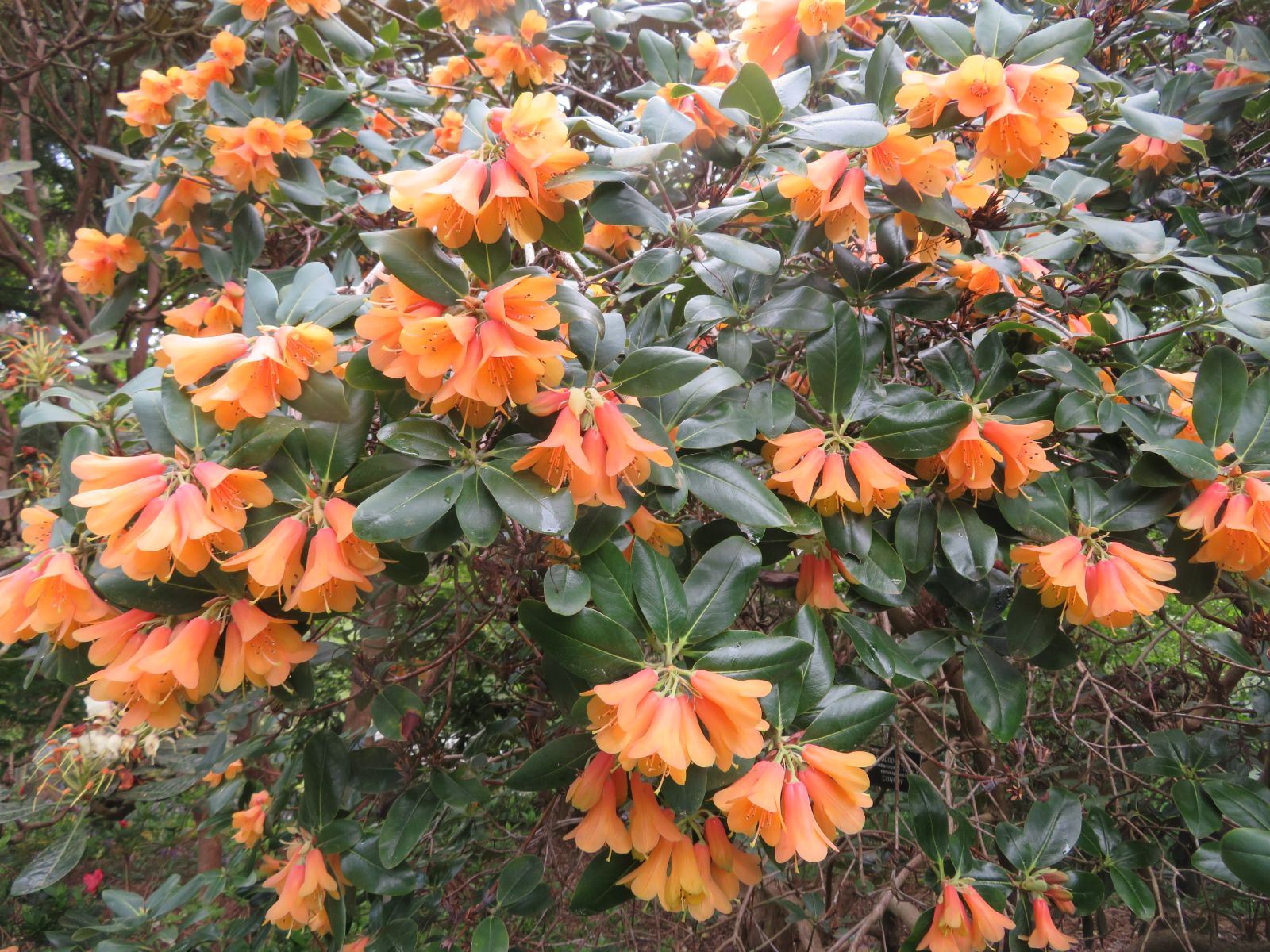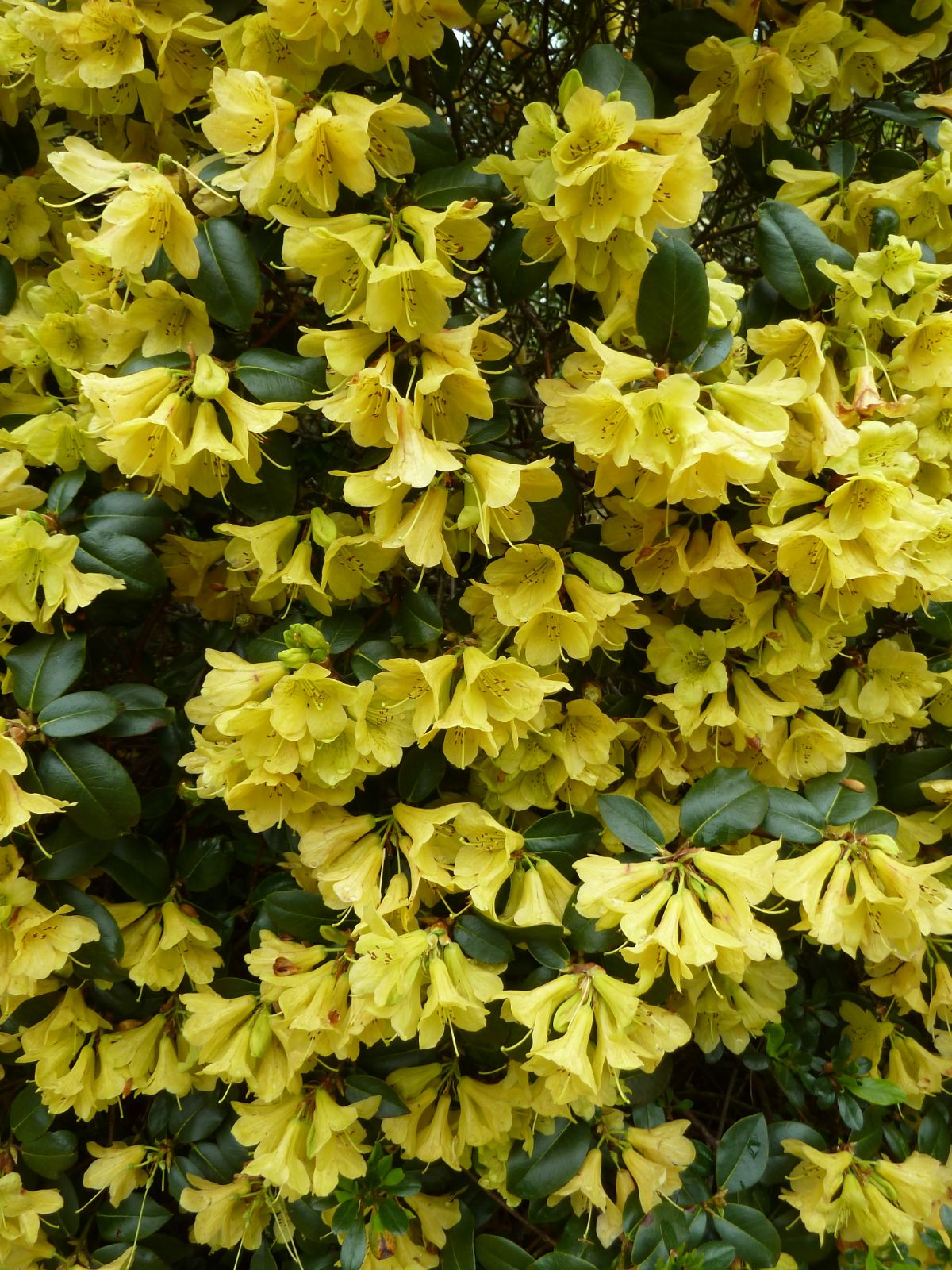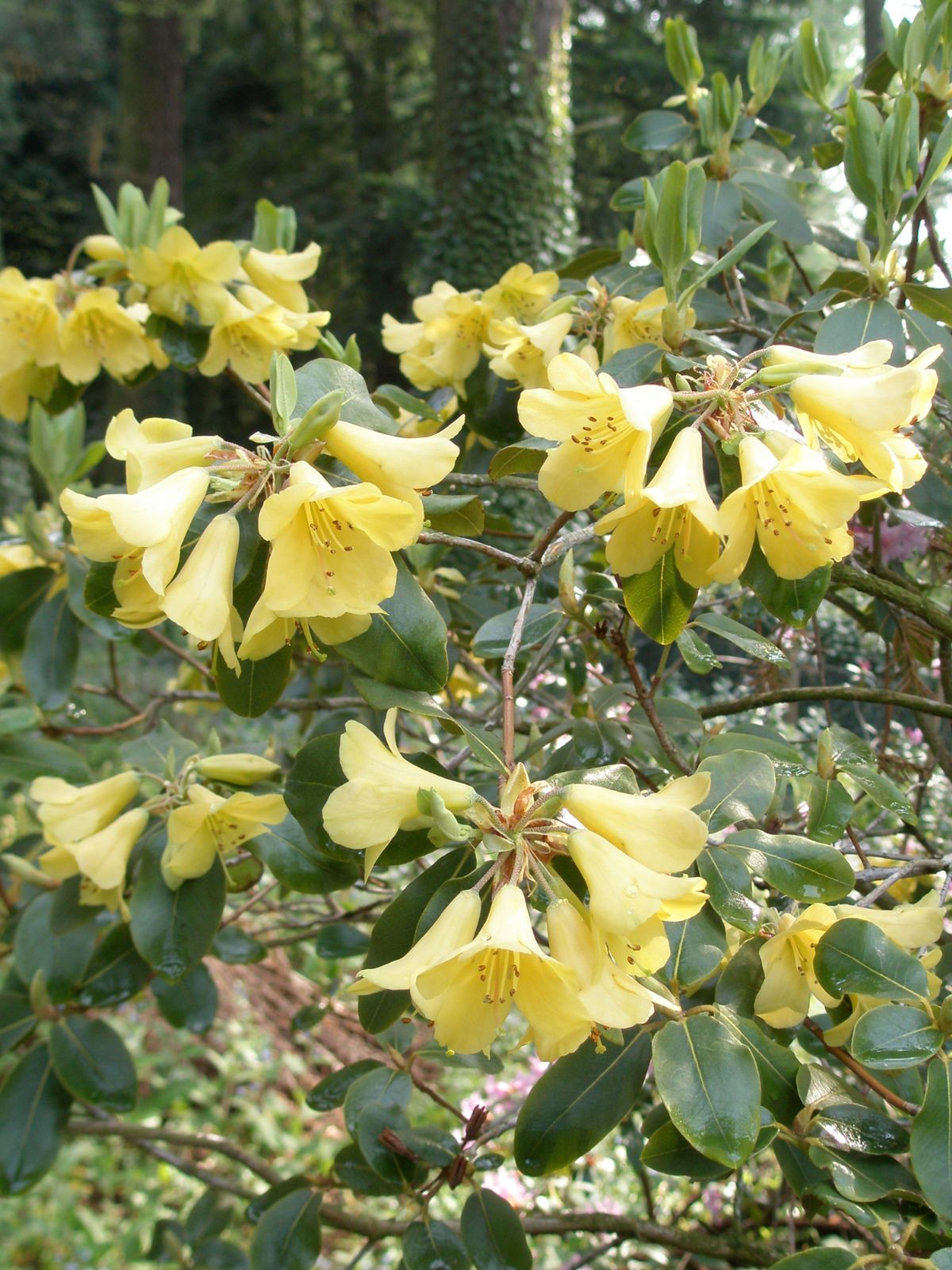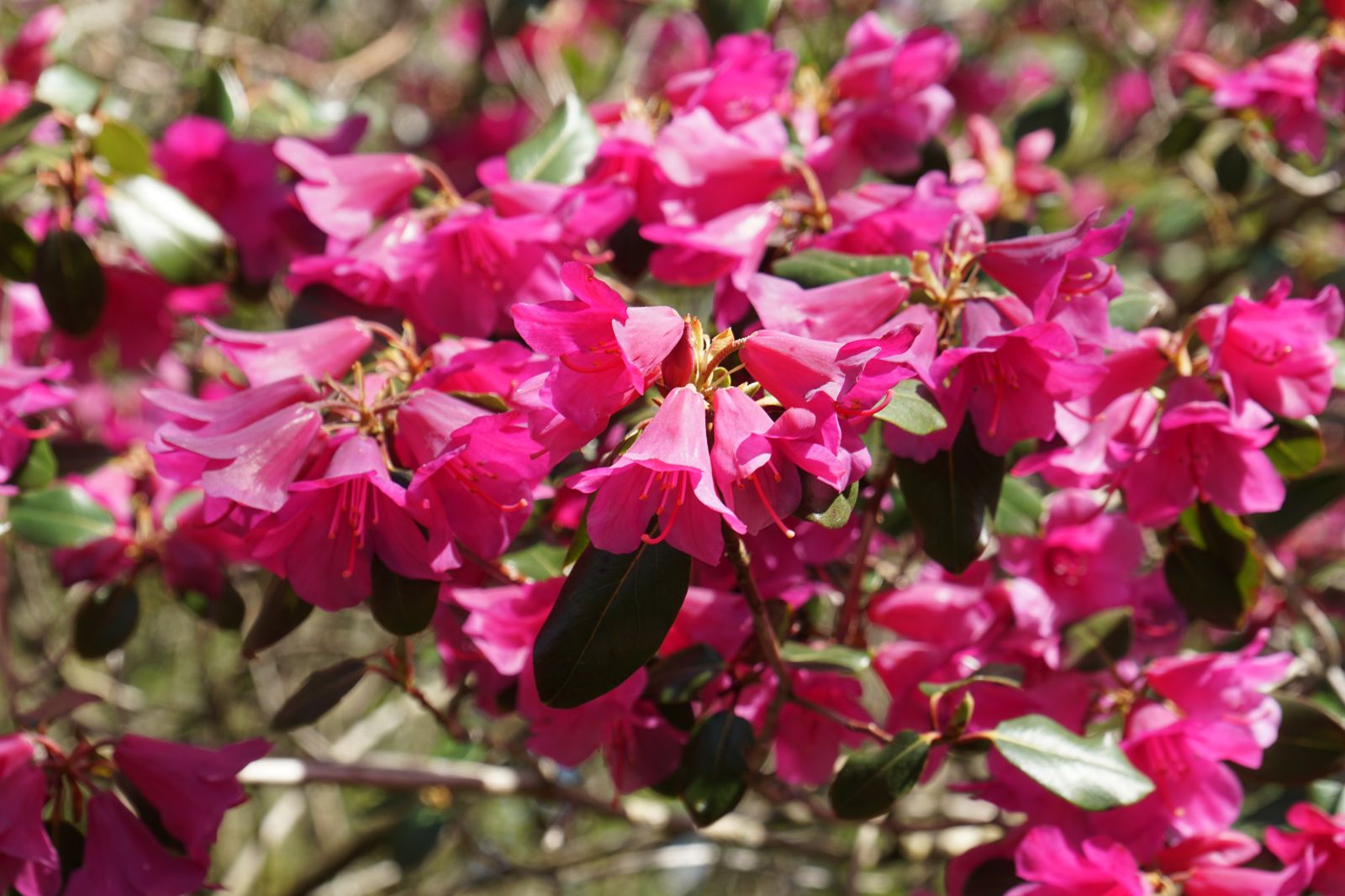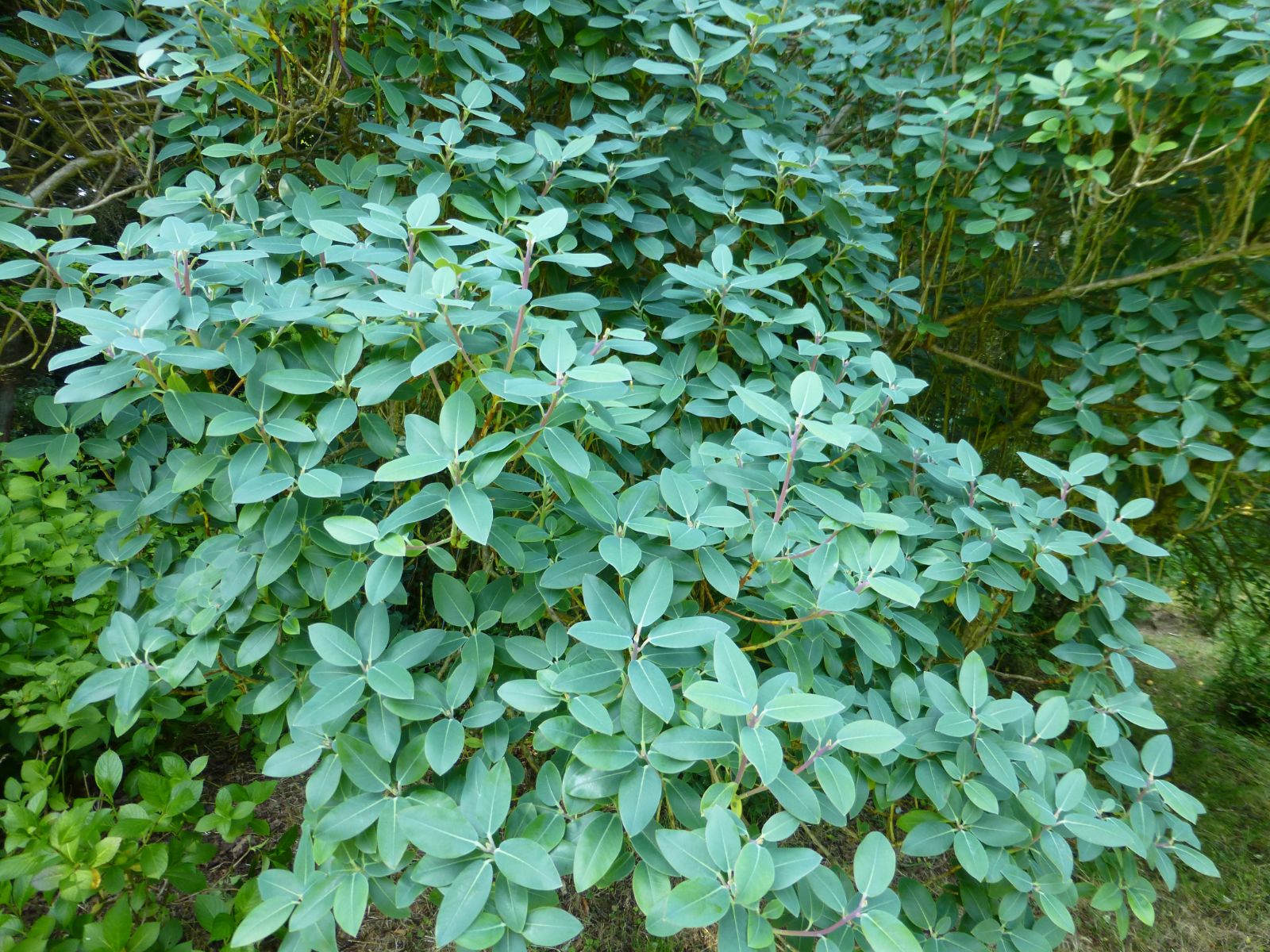Rhododendron cinnabarinum
Sponsor
Kindly sponsored by
Peter Norris, enabling the use of The Rhododendron Handbook 1998
Credits
Article from Bean's Trees and Shrubs Hardy in the British Isles
Recommended citation
'Rhododendron cinnabarinum' from the website Trees and Shrubs Online (treesandshrubsonline.
Genus
- Rhododendron
- Subsect. Cinnabarina
Infraspecifics
Other taxa in genus
- Menziesia multiflora
- Rhododendron aberconwayi
- Rhododendron acuminatum
- Rhododendron adenogynum
- Rhododendron adenopodum
- Rhododendron adenosum
- Rhododendron aequabile
- Rhododendron afghanicum
- Rhododendron aganniphum
- Rhododendron agastum
- Rhododendron × agastum
- Rhododendron alabamense
- Rhododendron albertsenianum
- Rhododendron albiflorum
- Rhododendron albrechtii
- Rhododendron album
- Rhododendron alticolum
- Rhododendron alutaceum
- Rhododendron amagianum
- Rhododendron ambiguum
- Rhododendron amesiae
- Rhododendron anagalliflorum
- Rhododendron annae
- Rhododendron anthopogon
- Rhododendron anthopogonoides
- Rhododendron anthosphaerum
- Rhododendron anwheiense
- Rhododendron aperantum
- Rhododendron araiophyllum
- Rhododendron arborescens
- Rhododendron arboreum
- Rhododendron arfakianum
- Rhododendron argipeplum
- Rhododendron argyrophyllum
- Rhododendron arizelum
- Rhododendron armitii
- Rhododendron atlanticum
- Rhododendron atropurpureum
- Rhododendron atrovirens
- Rhododendron augustinii
- Rhododendron aureum
- Rhododendron auriculatum
- Rhododendron aurigeranum
- Rhododendron auritum
- Rhododendron austrinum
- Rhododendron baenitzianum
- Rhododendron bagobonum
- Rhododendron baileyi
- Rhododendron bainbridgeanum
- Rhododendron balangense
- Rhododendron balfourianum
- Rhododendron barbatum
- Rhododendron basilicum
- Rhododendron batemanii
- Rhododendron bathyphyllum
- Rhododendron beanianum
- Rhododendron beesianum
- Rhododendron beyerinckianum
- Rhododendron bhutanense
- Rhododendron blackii
- Rhododendron boothii
- Rhododendron brachyanthum
- Rhododendron brachycarpum
- Rhododendron bracteatum
- Rhododendron brevistylum
- Rhododendron brookeanum
- Rhododendron bryophilum
- Rhododendron bureavii
- Rhododendron bureavioides
- Rhododendron burmanicum
- Rhododendron burttii
- Rhododendron buxifolium
- Rhododendron caesium
- Rhododendron calendulaceum
- Rhododendron caliginis
- Rhododendron callimorphum
- Rhododendron calophytum
- Rhododendron calostrotum
- Rhododendron caloxanthum
- Rhododendron calvescens
- Rhododendron camelliiflorum
- Rhododendron campanulatum
- Rhododendron campylocarpum
- Rhododendron campylogynum
- Rhododendron camtschaticum
- Rhododendron canadense
- Rhododendron x candelabrum
- Rhododendron canescens
- Rhododendron capitatum
- Rhododendron carneum
- Rhododendron carolinianum
- Rhododendron carrii
- Rhododendron carringtoniae
- Rhododendron catacosmum
- Rhododendron catawbiense
- Rhododendron caucasicum
- Rhododendron cephalanthum
- Rhododendron cerasinum
- Rhododendron chaetomallum
- Rhododendron chamaethomsonii
- Rhododendron championiae
- Rhododendron charitopes
- Rhododendron chionanthum
- Rhododendron chlorops
- Rhododendron christi
- Rhododendron christianae
- Rhododendron chryseum
- Rhododendron chrysodoron
- Rhododendron ciliatum
- Rhododendron ciliicalyx
- Rhododendron citriniflorum
- Rhododendron clementinae
- Rhododendron coelicum
- Rhododendron coeloneuron
- Rhododendron collettianum
- Rhododendron columbianum
- Rhododendron commonae
- Rhododendron complexum
- Rhododendron concinnum
- Rhododendron coriaceum
- Rhododendron coryanum
- Rhododendron cowanianum
- Rhododendron coxianum
- Rhododendron crassifolium
- Rhododendron crassum
- Rhododendron crinigerum
- Rhododendron cruttwellii
- Rhododendron cuffeanum
- Rhododendron culminicolum
- Rhododendron cumberlandense
- Rhododendron cuneatum
- Rhododendron cyanocarpum
- Rhododendron dalhousiae
- Rhododendron dasypetalum
- Rhododendron dauricum
- Rhododendron davidii
- Rhododendron davidsonianum
- Rhododendron decandrum
- Rhododendron × decipiens
- Rhododendron decorum
- Rhododendron degronianum
- Rhododendron dendricola
- Rhododendron dendrocharis
- Rhododendron denudatum
- Rhododendron desquamatum
- Rhododendron detonsum
- Rhododendron dianthosmum
- Rhododendron diaprepes
- Rhododendron dichroanthum
- Rhododendron dielsianum
- Rhododendron dignabile
- Rhododendron dilatatum
- Rhododendron dimitrium
- Rhododendron diphrocalyx
- Rhododendron discolor
- Rhododendron dryophyllum
- Rhododendron eclecteum
- Rhododendron × edgarianum
- Rhododendron edgeworthii
- Rhododendron elegantulum
- Rhododendron elliottii
- Rhododendron ericoides
- Rhododendron eriocarpum
- Rhododendron eriogynum
- Rhododendron erosum
- Rhododendron × erythrocalyx
- Rhododendron esetulosum
- Rhododendron eudoxum
- Rhododendron eurysiphon
- Rhododendron exasperatum
- Rhododendron excellens
- Rhododendron faberi
- Rhododendron facetum
- Rhododendron falconeri
- Rhododendron fallacinum
- Rhododendron fargesii
- Rhododendron farrerae
- Rhododendron fastigiatum
- Rhododendron faucium
- Rhododendron ferrugineum
- Rhododendron fictolacteum
- Rhododendron flammeum
- Rhododendron flavidum
- Rhododendron fletcherianum
- Rhododendron flinckii
- Rhododendron floccigerum
- Rhododendron floribundum
- Rhododendron flumineum
- Rhododendron formosanum
- Rhododendron formosum
- Rhododendron forrestii
- Rhododendron fortunei
- Rhododendron fragariiflorum
- Rhododendron fulgens
- Rhododendron fulvastrum
- Rhododendron fulvum
- Rhododendron galactinum
- Rhododendron gardenia
- Rhododendron genestierianum
- Rhododendron giulianettii
- Rhododendron glanduliferum
- Rhododendron glaucophyllum
- Rhododendron glischroides
- Rhododendron glischrum
- Rhododendron goodenoughii
- Rhododendron goreri
- Rhododendron gracilentum
- Rhododendron grande
- Rhododendron griersonianum
- Rhododendron griffithianum
- Rhododendron groenlandicum
- Rhododendron grothausii
- Rhododendron gymnocarpum
- Rhododendron habrotrichum
- Rhododendron haematodes
- Rhododendron hanceanum
- Rhododendron haofui
- Rhododendron headfortianum
- Rhododendron hedyosmum
- Rhododendron heftii
- Rhododendron heliolepis
- Rhododendron hellwigii
- Rhododendron hemitrichotum
- Rhododendron hemsleyanum
- Rhododendron herzogii
- Rhododendron hidakanum
- Rhododendron × hillieri
- Rhododendron himantodes
- Rhododendron hippophaeoides
- Rhododendron hirsutum
- Rhododendron hirtipes
- Rhododendron hodgsonii
- Rhododendron hongkongense
- Rhododendron hooglandii
- Rhododendron hookeri
- Rhododendron horlickianum
- Rhododendron houlstonii
- Rhododendron huianum
- Rhododendron hunnewellianum
- Rhododendron hyacinthosmum
- Rhododendron hylaeum
- Rhododendron hyperythrum
- Rhododendron hypoleucum
- Rhododendron imberbe
- Rhododendron impeditum
- Rhododendron imperator
- Rhododendron inconspicuum
- Rhododendron indicum
- Rhododendron inopinum
- Rhododendron insigne
- Rhododendron intranervatum
- Rhododendron intricatum
- Rhododendron irroratum
- Rhododendron japonicum
- Rhododendron jasminiflorum
- Rhododendron javanicum
- Rhododendron johnstoneanum
- Rhododendron kaempferi
- Rhododendron kanehirae
- Rhododendron kawakamii
- Rhododendron keiskei
- Rhododendron keleticum
- Rhododendron kendrickii
- Rhododendron kesangiae
- Rhododendron keysii
- Rhododendron kiusianum
- Rhododendron kiyosumense
- Rhododendron kongboense
- Rhododendron konori
- Rhododendron kyawii
- Rhododendron lacteum
- Rhododendron laetum
- Rhododendron lagopus
- Rhododendron lanatoides
- Rhododendron lanatum
- Rhododendron lanceolatum
- Rhododendron lanigerum
- Rhododendron lapponicum
- Rhododendron latoucheae
- Rhododendron laudandum
- Rhododendron lepidostylum
- Rhododendron lepidotum
- Rhododendron leptanthum
- Rhododendron leptocarpum
- Rhododendron leptothrium
- Rhododendron leucaspis
- Rhododendron leucogigas
- Rhododendron levinei
- Rhododendron lindaueanum
- Rhododendron lindleyi
- Rhododendron lochiae
- Rhododendron longesquamatum
- Rhododendron longiflorum
- Rhododendron longipes
- Rhododendron longistylum
- Rhododendron loranthiflorum
- Rhododendron lowii
- Rhododendron lowndesii
- Rhododendron luciferum
- Rhododendron ludlowii
- Rhododendron ludwigianum
- Rhododendron lukiangense
- Rhododendron luraluense
- Rhododendron luteiflorum
- Rhododendron lutescens
- Rhododendron luteum
- Rhododendron lyi
- Rhododendron lysolepis
- Rhododendron macabeanum
- Rhododendron macgregoriae
- Rhododendron macrophyllum
- Rhododendron macrosepalum
- Rhododendron maculiferum
- Rhododendron maddenii
- Rhododendron magnificum
- Rhododendron maius
- Rhododendron makinoi
- Rhododendron malayanum
- Rhododendron mallotum
- Rhododendron mariesii
- Rhododendron martinianum
- Rhododendron maximum
- Rhododendron maybarae
- Rhododendron meddianum
- Rhododendron megacalyx
- Rhododendron megeratum
- Rhododendron mekongense
- Rhododendron micranthum
- Rhododendron microgynum
- Rhododendron micromalayanum
- Rhododendron microphyton
- Rhododendron mimetes
- Rhododendron minus
- Rhododendron molle
- Rhododendron mollicomum
- Rhododendron mollyanum
- Rhododendron monosematum
- Rhododendron montroseanum
- Rhododendron morii
- Rhododendron moulmainense
- Rhododendron moupinense
- Rhododendron mucronatum
- Rhododendron mucronulatum
- Rhododendron multicolor
- Rhododendron multinervium
- Rhododendron myrtifolium
- Rhododendron nakaharae
- Rhododendron nakotiltum
- Rhododendron neoglandulosum
- Rhododendron neriiflorum
- Rhododendron nervulosum
- Rhododendron nigroglandulosum
- Rhododendron nipponicum
- Rhododendron nitidulum
- Rhododendron nivale
- Rhododendron niveum
- Rhododendron noriakianum
- Rhododendron notiale
- Rhododendron nudipes
- Rhododendron nuttallii
- Rhododendron oblongifolium
- Rhododendron obtusum
- Rhododendron occidentale
- Rhododendron ochraceum
- Rhododendron oldhamii
- Rhododendron orbiculare
- Rhododendron orbiculatum
- Rhododendron oreodoxa
- Rhododendron oreotrephes
- Rhododendron orthocladum
- Rhododendron ovatum
- Rhododendron pachypodum
- Rhododendron pachysanthum
- Rhododendron pachytrichum
- Rhododendron papillatum
- Rhododendron paradoxum
- Rhododendron parmulatum
- Rhododendron parryae
- Rhododendron parvifolium
- Rhododendron pauciflorum
- Rhododendron pemakoense
- Rhododendron pendulum
- Rhododendron pentaphyllum
- Rhododendron perakense
- Rhododendron peregrinum
- Rhododendron periclymenoides
- Rhododendron phaeochitum
- Rhododendron phaeochrysum
- Rhododendron piercei
- Rhododendron pingianum
- Rhododendron × planecostatum
- Rhododendron planetum
- Rhododendron pleianthum
- Rhododendron pleistanthum
- Rhododendron pocophorum
- Rhododendron poluninii
- Rhododendron polyanthemum
- Rhododendron polycladum
- Rhododendron polylepis
- Rhododendron ponticum
- Rhododendron praestans
- Rhododendron praeteritum
- Rhododendron praetervisum
- Rhododendron praevernum
- Rhododendron prattii
- Rhododendron preptum
- Rhododendron primuliflorum
- Rhododendron principis
- Rhododendron prinophyllum
- Rhododendron pronum
- Rhododendron proteoides
- Rhododendron protistum
- Rhododendron pruniflorum
- Rhododendron prunifolium
- Rhododendron przewalskii
- Rhododendron pseudochrysanthum
- Rhododendron pubescens
- Rhododendron pudorosum
- Rhododendron pulchrum
- Rhododendron pumilum
- Rhododendron purdomii
- Rhododendron purpureiflorum
- Rhododendron quadrasianum
- Rhododendron quinquefolium
- Rhododendron racemosum
- Rhododendron ramsdenianum
- Rhododendron rarilepidotum
- Rhododendron rarum
- Rhododendron recurvoides
- Rhododendron reticulatum
- Rhododendron retivenium
- Rhododendron retusum
- Rhododendron rex
- Rhododendron rhodoleucum
- Rhododendron rigidum
- Rhododendron ripense
- Rhododendron ririei
- Rhododendron robinsonii
- Rhododendron roseatum
- Rhododendron rothschildii
- Rhododendron roxieanum
- Rhododendron rubiginosum
- Rhododendron rubineiflorum
- Rhododendron rubropilosum
- Rhododendron rufum
- Rhododendron rugosum
- Rhododendron rupicola
- Rhododendron russatum
- Rhododendron saisiuense
- Rhododendron saluenense
- Rhododendron sanctum
- Rhododendron sanguineum
- Rhododendron santapaui
- Rhododendron sargentianum
- Rhododendron saxicolum
- Rhododendron saxifragoides
- Rhododendron sayeri
- Rhododendron scabridibracteum
- Rhododendron scabrifolium
- Rhododendron scabrum
- Rhododendron schlippenbachii
- Rhododendron schoddei
- Rhododendron scintillans
- Rhododendron scopulorum
- Rhododendron searleanum
- Rhododendron searsiae
- Rhododendron seinghkuense
- Rhododendron selense
- Rhododendron semibarbatum
- Rhododendron semnoides
- Rhododendron serotinum
- Rhododendron serpyllifolium
- Rhododendron sessilifolium
- Rhododendron setosum
- Rhododendron × sheilae
- Rhododendron shepherdii
- Rhododendron sherriffii
- Rhododendron shweliense
- Rhododendron sidereum
- Rhododendron siderophyllum
- Rhododendron sikangense
- Rhododendron simiarum
- Rhododendron simsii
- Rhododendron sinofalconeri
- Rhododendron sinogrande
- Rhododendron smirnowii
- Rhododendron × sochadzeae
- Rhododendron solitarium
- Rhododendron sororium
- Rhododendron souliei
- Rhododendron sperabile
- Rhododendron sperabiloides
- Rhododendron sphaeroblastum
- Rhododendron spiciferum
- Rhododendron spilotum
- Rhododendron spinuliferum
- Rhododendron stamineum
- Rhododendron stapfianum
- Rhododendron stenopetalum
- Rhododendron stenophyllum
- Rhododendron stevensianum
- Rhododendron stewartianum
- Rhododendron strigillosum
- Rhododendron suaveolens
- Rhododendron subansiriense
- Rhododendron subsessile
- Rhododendron succothii
- Rhododendron sulfureum
- Rhododendron sumatranum
- Rhododendron superbum
- Rhododendron sutchuenense
- Rhododendron taggianum
- Rhododendron taliense
- Rhododendron tanastylum
- Rhododendron tapetiforme
- Rhododendron tashiroi
- Rhododendron tatsienense
- Rhododendron telmateium
- Rhododendron temenium
- Rhododendron tephropeplum
- Rhododendron thayerianum
- Rhododendron thomsonii
- Rhododendron thymifolium
- Rhododendron tolmachevii
- Rhododendron tomentosum
- Rhododendron tosaense
- Rhododendron traillianum
- Rhododendron trichanthum
- Rhododendron trichocladum
- Rhododendron trichostomum
- Rhododendron triflorum
- Rhododendron tsariense
- Rhododendron tschonoskii
- Rhododendron tschonoskyi
- Rhododendron tsusiophyllum
- Rhododendron tuba
- Rhododendron ungernii
- Rhododendron uniflorum
- Rhododendron uvariifolium
- Rhododendron vaccinioides
- Rhododendron valentinianum
- Rhododendron vaseyi
- Rhododendron veitchianum
- Rhododendron venator
- Rhododendron vernicosum
- Rhododendron verruculosum
- Rhododendron versteegii
- Rhododendron vesiculiferum
- Rhododendron vialii
- Rhododendron vilmorinianum
- Rhododendron virgatum
- Rhododendron viridescens
- Rhododendron viscidifolium
- Rhododendron viscosum
- Rhododendron vitis-idaea
- Rhododendron wadanum
- Rhododendron wallichii
- Rhododendron walongense
- Rhododendron wardii
- Rhododendron wasonii
- Rhododendron watsonii
- Rhododendron websterianum
- Rhododendron weyrichii
- Rhododendron wightii
- Rhododendron williamsianum
- Rhododendron williamsii
- Rhododendron wilsoniae
- Rhododendron wiltonii
- Rhododendron womersleyi
- Rhododendron wongii
- Rhododendron wrightianum
- Rhododendron xanthocodon
- Rhododendron xanthostephanum
- Rhododendron yakushimanum
- Rhododendron yedoense
- Rhododendron yelliotii
- Rhododendron yongii
- Rhododendron yungningense
- Rhododendron yunnanense
- Rhododendron zaleucum
- Rhododendron zeylanicum
- Rhododendron zoelleri
Straggling shrub, up to 7 m; young shoots scaly, often also pruinose. Leaves sometimes deciduous, 3–9 × 2.7–5 cm, broadly or narrowly elliptic, apex rounded, lower surface covered in fleshy narrowly rimmed, equal or unequal scales. Pedicels scaly. Flowers 2–7 per inflorescence, yellow or orange, to purple sometimes bicoloured, yellow and orange, usually with a waxy pruinose bloom, tubular to campanulate, 25–36 mm; stamens 10; ovary scaly, sometimes also puberulous, style usually glabrous. Flowering April-May. Royal Horticultural Society (1997)
Distribution Myanmar N China S Tibet India W Bengal, Sikkim
Habitat 2,750–3,950 m
RHS Hardiness Rating H5
Conservation status Least concern (LC)
An evergreen shrub 6 to 10 ft high, sometimes taller, somewhat thin and sparse of habit, the branches long and slender, scaly when young. Leaves 2 to 4 in. long, 3⁄4 to 11⁄4 in. broad; oval, tapering about equally to each end, glabrous, and of a greyish-green metallic lustre above, scaly beneath, and varying in colour from glaucous green to reddish brown; stalk 1⁄3 in. long. Flowers funnel-shaped, and like those of Lapageria, 11⁄4 to 2 in. long, very variable in colour; ordinarily of a dull cinnabar red, produced during May and June, from five to eight in terminal heads. In other forms the corolla is orange-red outside, yellowish within, sometimes greenish. Flower-stalk 1⁄3 in. long, scaly. Calyx with four short, broadish lobes, and one longer narrow one, or sometimes with all five nearly equal, scaly. Stamens ten, scarcely so long as the corolla, hairy at the base, (s. Cinnabarinum)
Native of the Himalaya from E. Nepal to the region of the Tsangpo bend and slightly beyond, but not reported from Burma or China; discovered by J. D. Hooker in Sikkim and introduced by him in 1850. This distinct and interesting species is remarkable for the variability of the colour of its flowers and of the undersurface of its leaves. But the differences between some of the intermediate forms are so unimportant that botanists regard them all of one species. The following variants, mostly only of horticultural interest, have been named:
From the Supplement (Vol. V)
The main distribution of the typical subspecies of R. cinnabarinum is from east Nepal to Bhutan, but Cox and Hutchison collected seed in the Assam Himalaya under their number 579. Some recent introductions from east Nepal are B. L. & M. 280 and Schilling 2470. An Award of Merit was given in 1977 to the clone ‘Nepal’, raised by J. B. Stevenson from Ludlow, Sherriff and Hicks 21283, shown by Hydon Nursery (foliage glaucous; flowers yellow passing to crimson at the base). The varieties aestivale, blandfordiiflorum and roylei are not recognised in the Edinburgh revision, but the last two could be retained as the Blandfordiiflorum and Roylei groups. The first could be taken as a clonal name, being based on a single garden plant.
subsp. xanthocodon (Hutch.) Cullen R. xanthocodon Hutch.; R. concatenans Hutch.; R. cinnabarinum var. pallidum Hook.f.; R. cinnabarinum var. purpurellum Cowan – The distinguishing characters given by Dr Cullen are: leaves relatively broader than in subsp. cinnabarinum, usually persistently lepidote above; flowers campanulate against tubular-campanulate. The flowers are variable in colour, certainly not always yellow or orange. This subspecies has a more easterly distribution than subsp. cinnabarinum, but there is a considerable overlap.
It has been suggested that the submerged name R. concatenans could be maintained as R. cinnabarinum subsp. xanthocodon Concatenans group, but there might be difficulty in defining such a group, given the variability of the plants raised from the seeds collected by Kingdon Ward and later by the Ludlow and Sherriff expeditions, and hitherto grown as R. concatenans.
† subsp. tamaense (Davidian) Cullen R. tamaense Davidian – This interesting rhododendron was described from specimens collected by Kingdon Ward in 1953 on the Tama Bum in The Triangle of northern Burma (the mountainous region between the two upper branches of the Irrawaddy) and was introduced by him (KW 21021). Its distinguishing characters are the almost deciduous leaves and the presence of scales on the outside of the corolla, which is campanulate and purple. Although it was not mentioned in the original description of R. tamaense, it was Farrer and not Kingdon Ward who discovered this rhododendron, some thirty-four years earlier (Farrer 1615, collected to the east of the type-locality).
subsp. cinnabarinum
Synonyms
R. blandfordiiflorum Hook.
R. roylei Hook.f.
Corolla scaly outside, most leaves evergreen; leaves relatively narrow, more than 2.2 × as long as broad; corolla usually more or less tubular-campanulate.
Distribution Nepal, India (W Bengal, Sikkim), Bhutan, China (S Tibet).
Habitat 2,750–3,950m.
Awards AM 1918 (Messrs Reuthe, Keston, Kent) to a clone ‘Magnificum’, as var. roylei; flowers exceptionally large, orange-red. AM 1953 (Crown Estate Commissioners, Windsor) to a clone ‘Vin Rose’, as var. roylei; flowers Currant Red outside, Blood Red inside, with a waxy bloom. AM 1977 (Hydon Nurseries Ltd, Godalming) to a clone ‘Nepal’, from L., S. & H. 21283; flowers yellow, becoming red at base. AM 1945 (Lord Aberconway, Bodnant) as var. blandfordiiflorum; flowers vermilion at base externally, paler above. AGM 1993, to a clone ‘Conroy’.
subsp. tamaense (Davidian) Cullen
Corolla lobes scaly outside; most leaves deciduous; corolla campanulate, purple.
Distribution N Burma.
Habitat 2,750–3,200m.
Awards AM 1978 (Maj. A.E. Hardy, Sandling Park, Kent) to a clone ‘Triangle’ of R. tamaense; flowers white in throat, flushed purple, spotted red-purple.
Taxonomic note (R. tamaense Davidian)
Subsp. tamaense, with a more Easterly distribution than the remaining subspecies, represents the end of a geographical cline.
subsp. xanthocodon (Hutch.) Cullen
Synonyms
R. concatenans Hutch.
R. xanthocodon Hutch.
R. cinnabarinum var. purpurellum Cowan Cowan
Corolla scaly outside, most leaves evergreen; leaves relatively broad, less than 2.2× as long as broad; corolla usually campanulate.
Distribution India (Arunachal Pradesh), Bhutan, China (S Tibet).
Habitat 3,050–3,950m.
Awards AM 1935 (L. de Rothschild, Exbury) from Kingdon-Ward 6026; flowers yellow. AM 1950 (Capt. c. Ingram, Benenden, Kent) to a clone ‘Copper’, as R. concatenans, from L. & S. 6560; flowers coral coloured, suffused with orange and red. FCC 1935 (Lt Col L.C.R. Messel, Nymans, Sussex) as R. concatenans, from Kingdon-Ward 5874; flowers apricot, flushed rose externally. There is some doubt that this plant is correctly named. AM 1951 (Capt. C. Ingram, Benenden, Kent) as var. purpurellum, from L. & S. 6349A. AGM 1993
var. aestivale Hutch
This name was given by Dr Hutchinson to a plant growing at Borde Hill, Sussex, which was unusually late-flowering (July) and had narrower leaves than normal.var. blandfordiiflorum Hook
Flowers red outside, yellowish or greenish within. Bot. Mag., t. 4930. Introduced by J. D. Hooker. A plant of this character received an Award of Merit when shown from Bodnant on May 29, 1945.var. pallidum
Synonyms
Bot. Mag ., t. 4788
var. purpurellum Cowan
Flowers shorter than in the type and campanulate, rich plum-purple. Described from Ludlow and Sherriff 1354, collected in the Tibetan Himalaya in 1936. Award of Merit May 1, 1951, when shown by Capt. Collingwood Ingram, Benenden, Kent (raised from Ludlow, Sherriff, and Taylor 6349).var. roylei (Hook, f.) Hort.
Synonyms
R. roylei Hook. f
Flowers intense rosy red or plum crimson. It was originally described by J. D. Hooker as a species. A few years later he sunk it in R. cinnabarinum but in gardens the name R. roylei continued to be used by gardeners, ‘who, quite reasonably, refuse to call the dusky beauty by the same name as the smaller-flowered orange or madder-coloured one’ (W. Watson, Gard. Chron., Vol. 64 (1918), p. 38). A selection from the var. roylei, named ‘Magnificum’, received an Award of Merit when shown by Messrs Reuthe on May 7, 1918. This was described as having flowers dark crimson on the outside, orange-red inside. The same award was given on May 19, 1953, to a clone named ‘Vin Rosé’, with flowers described as Currant Red outside, Blood Red inside, shown by the Crown Estate Commissioners, Windsor Great Park.R. cinnabarinum is a perfectly hardy species in a sheltered position, and needs only light shade. ‘This is one of those rhododendrons which looks its best when viewed with the sun behind a bush in flower. The effect is then dazzling, for there is a certain quality and brilliance added to the shining flowers, which is not noticeable when seen only against a dark background’ (Millais).R. cinnabarinum is a parent of many fine hybrids, the best known of which are the Lady Rosebery and Lady Chamberlain grexes. Details of these and others will be found in the section on hybrids.

